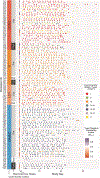Longitudinal profiles of the vaginal microbiota of pre-, peri-, and postmenopausal women: preliminary insights from a secondary data analysis
- PMID: 38787353
- PMCID: PMC11886898
- DOI: 10.1097/GME.0000000000002358
Longitudinal profiles of the vaginal microbiota of pre-, peri-, and postmenopausal women: preliminary insights from a secondary data analysis
Abstract
Objective: Menopause is often accompanied by lowered Lactobacillus spp. relative abundance and increased abundance of diverse anaerobic/aerobic bacteria in the vaginal microbiota due in part to declines in estrogen. These microbiota are associated with urogenital symptoms and infections. In premenopause, vaginal microbiota can fluctuate rapidly, particularly with menstrual cycles and sexual activity; however, the longitudinal dynamics of vaginal microbiota are understudied in peri- and postmenopause. We described vaginal community stability across reproductive stages.
Methods: Pre- (n = 83), peri- (n = 8), and postmenopausal (n = 11) participants provided twice-weekly mid-vaginal samples (total, 1,556; average, 15 per participant) over 8 weeks in an observational study. Composition of the vaginal microbiota was characterized by 16S rRNA gene amplicon sequencing, and a community state type (CST) was assigned to each sample. Clustering of longitudinal CST profiles, CST transition rates, duration of low-Lactobacillus/high bacterial diversity CSTs, and other metrics of bacterial community dynamics were assessed across reproductive stages.
Results: The proportion of participants with longitudinal CST profiles characterized by low-Lactobacillus CSTs was similar among pre- (38.6%), peri- (37.5%), and postmenopausal (36.4%) participants (P = 0.69). CST transition rates between consecutive samples were 21.1%, 16.7%, and 14.6% for pre-, peri-, and postmenopausal participants, respectively (P = 0.49). Low-Lactobacillus CST tended to persist for at least 4 weeks, irrespective of reproductive stage.
Conclusions: Findings from this small yet frequently sampled cohort revealed vaginal bacterial fluctuations over 8 weeks that were similar across reproductive stages. Larger and longer-term studies based on these preliminary data could provide insights into the influence of microbiota dynamics on urogenital outcomes during menopause.
Copyright © 2024 by The Menopause Society.
Conflict of interest statement
Financial disclosure/conflicts of interest: Jacques Ravel is a cofounder of LUCA Biologics, a biotechnology company focusing on translating microbiome research into live biotherapeutic drugs. The other authors have nothing to disclose.
Figures

References
-
- Hearps AC, Tyssen D, Srbinovski D, et al. Vaginal lactic acid elicits an anti-inflammatory response from human cervicovaginal epithelial cells and inhibits production of pro-inflammatory mediators associated with HIVacquisition. Mucosal Immunol 2017;10:1480–1490. doi: 10.1038/mi.2017.27 - DOI - PubMed
Publication types
MeSH terms
Substances
Grants and funding
LinkOut - more resources
Full Text Sources
Molecular Biology Databases
Miscellaneous

